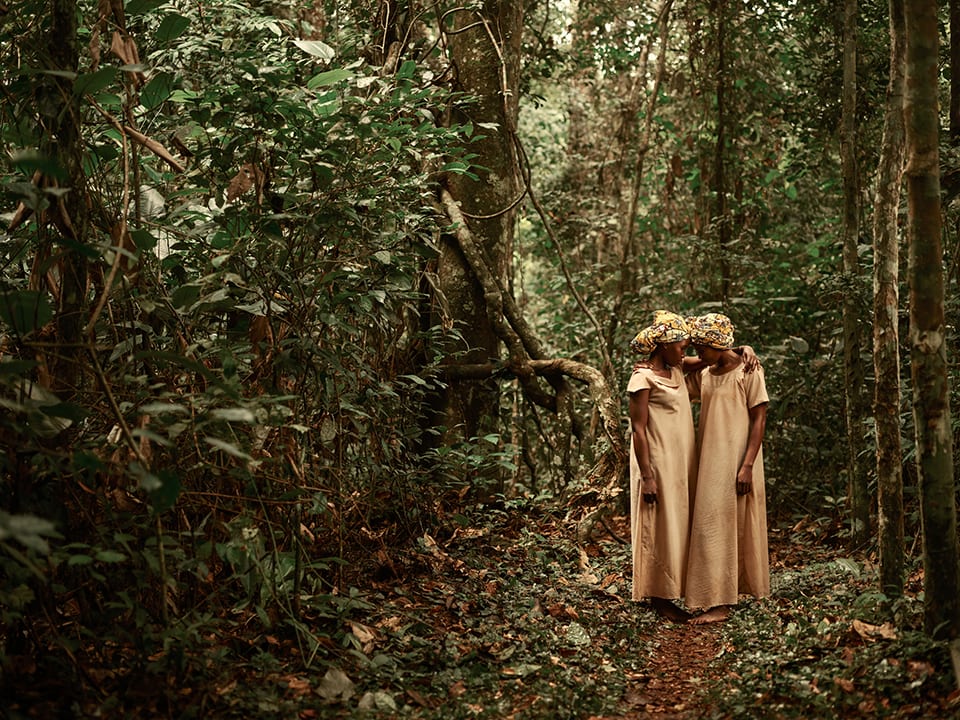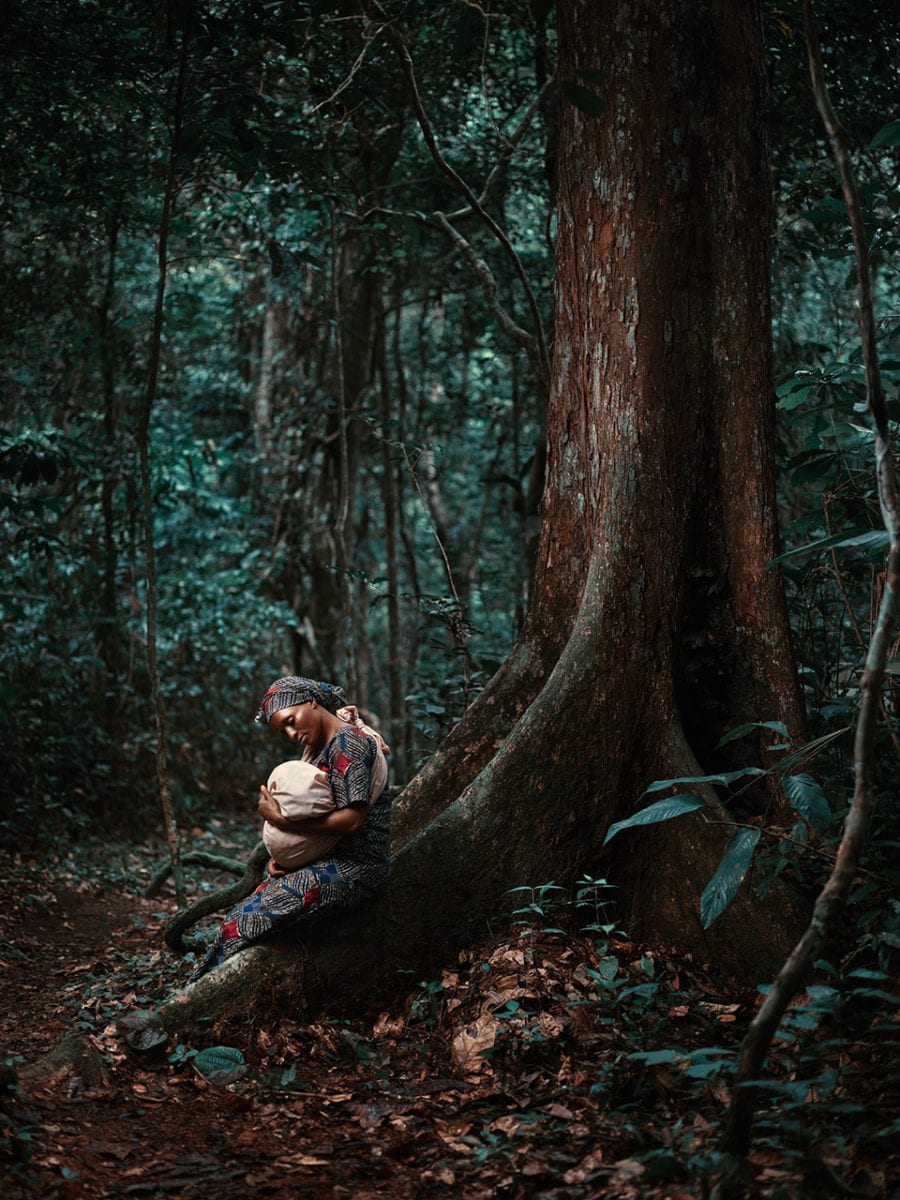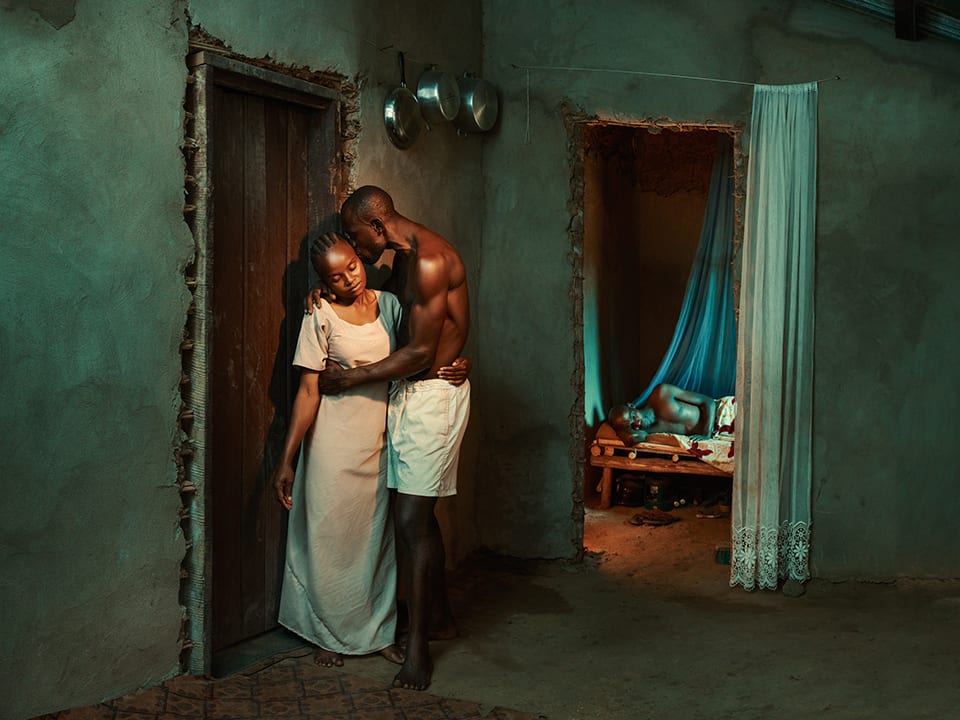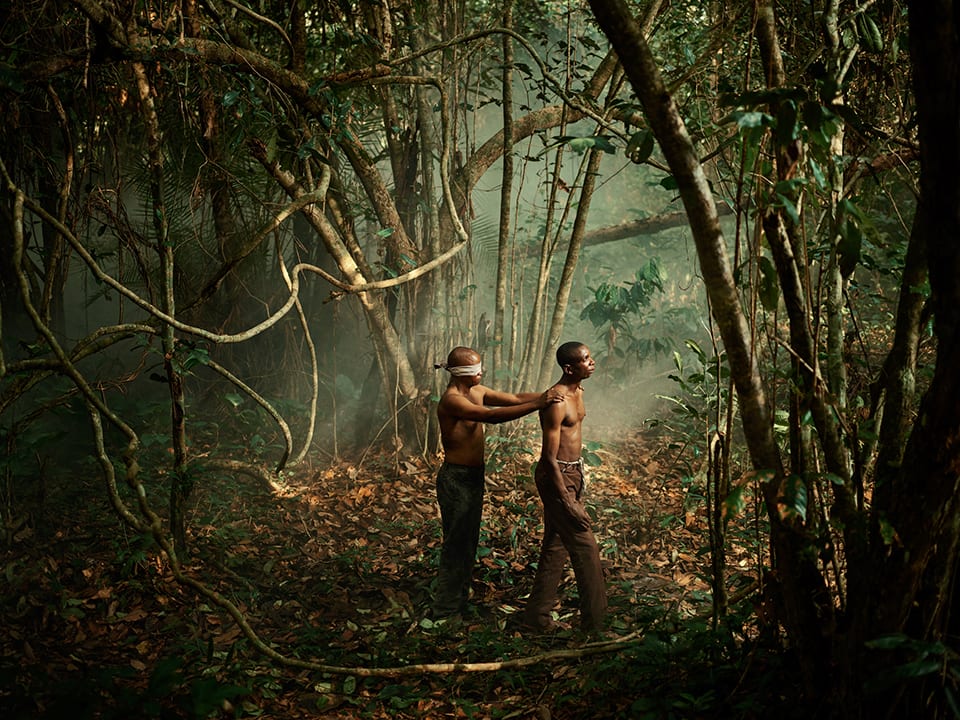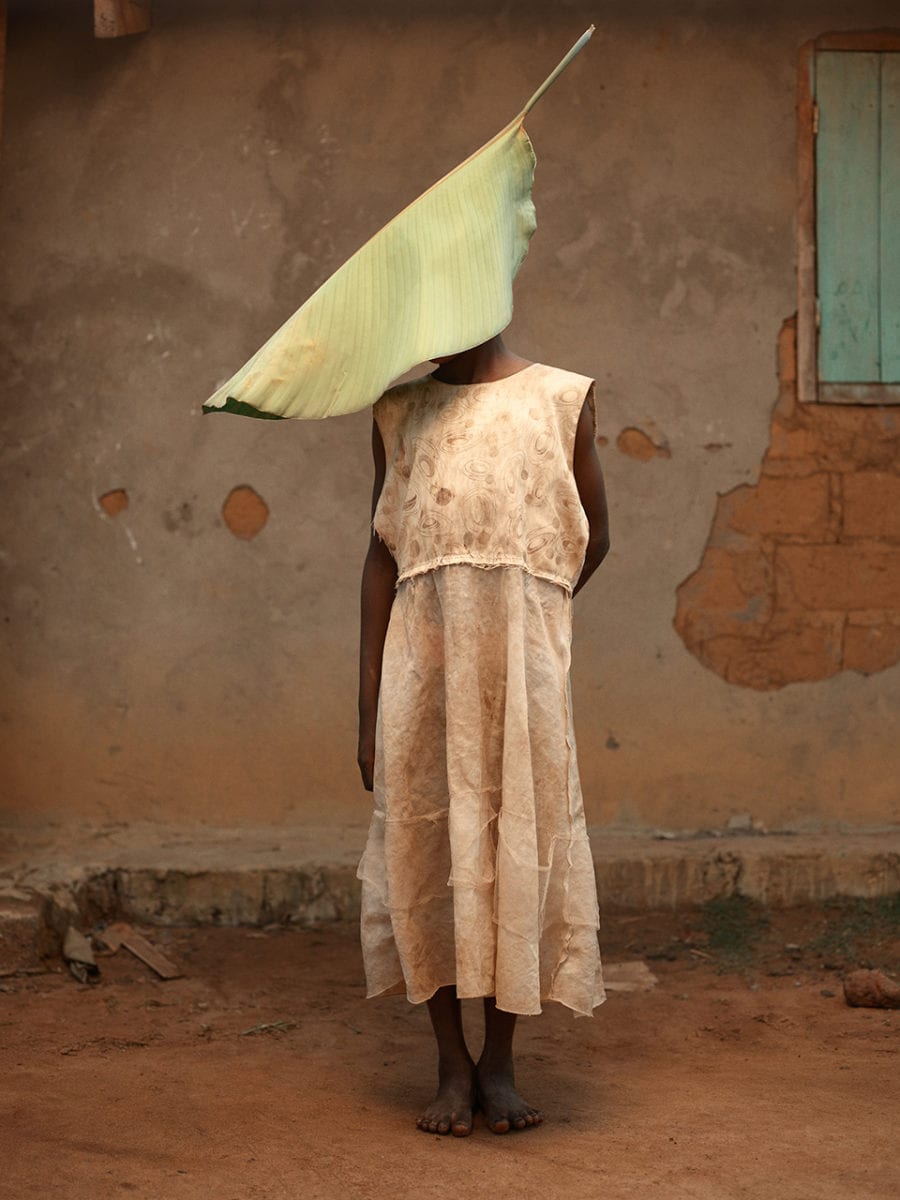A groundbreaking photography series depicts one of the world’s most important ecological locations as well as its diverse cultural narratives.
The Congo Basin is a tropical rainforest second only in size to the Amazon. It is described by ecologists as the earth’s “second lung” – vital to the climate emergency and just as vulnerable to deforestation as the Brazilian rainforest. Eva Vonk is a Berlin-based Producer and Creative Director of Tales of Us – an ongoing multimedia project that communicates the urgency of protecting the world’s most fragile ecosystems. From 2013, Vonk spent three years working closely with people in the Mbomo District of the Congo Basin to learn about the importance of oral culture and how it has developed through the communities.
Pieter Henket, a Dutch portrait photographer, has translated these stories into spell-binding images inspired by 17th century Golden Age painting. The resulting series, Congo Tales, raises awareness of the rainforest – spanning 500 million acres and six nations. Henket and Vonk speak to Aesthetica about their collaboration and its wider impact.
A: This series took five years to complete. How did the process change from start to finish? How did it develop –
both formally and stylistically?
EV: In 2013 my partner Stefanie Plattner and I were asked to create more awareness for the Congo Basin. At the time we both knew very little about this place. I was given the chance to travel to the Mbomo district in November 2013 for the first time. I joined highly ranked biologists, conservationists and other policy makers that were travelling there. Amongst them was a newly built school dedicated to improving early childhood development. It was here that I felt the first source of inspiration for a storytelling project. Oral culture is incredibly important in this region. Throughout our subsequent research trips, we were introduced to local knowledge passed on through storytelling. Stefanie and I had worked together as film producers, so our initial idea was to create a documentary. But once the stories started piling up, photography became a more logical medium.
PH: When you’re asked to join such an important cause, you have to ask how you are going to be able to create a group of images for which people pay attention. With 100 million images being uploaded onto Instagram each day, this is a challenge. Eva came to me with a story she had heard: that when an old person dies it’s like a library of stories burning down. I was able to combine that with my life-long wish of making a series of staged fairytale portraits. Each setup was carefully planned and staged. We spent two weeks before we began actually shooting, meeting with the people to discuss what moments and locations were important.
A: The Tales of Us project included spending three years working closely with the people in the Mbomo district in the Congo Basin. Why did you choose this location?
EV: It happened organically. When Stefanie and I were invited to develop an awareness campaign about the Congo Basin we travelled to the Odzala-Kokua National Park. I was very curious to get to know the people who actually live in the forest, and as such I quickly ended up in Mbomo. It is on the border of the national park and can be described as the capital of this region. There are many reasons why Stefanie and I selected this place, but one of them was the fact that many people in the area had to change their way of living after logging and hunting laws were implemented to protect the forest. Learning about this made us realise that we must pay attention to both culture and conservation working together. This is a somewhat sad reality when you know that these people live in the forest, but they weren’t the ones who endangered it in the first place. This region is a nexus point of nature, the unintended results of laws to protect it, and the wisdom of the people who live there.
A: What were some of the most memorable stories that you were told? How did you decide which to use? How much input did the Mbomo people have in staging?
EV: All the stories are meaningful in their own way. A personal favourite of mine is the story about the woman in the moon. In order to create the pictures, we worked with many women. It was an incredibly empowering process. We chose the stories as a collective. The main things we considered were equality in gender, cultures and religions. The series had to become a broad representation of the people you might meet; we were eager to be sensitive to inclusivity.
PH: As you can see, the people are truly telling the stories with their eyes. Instead of asking them to act things out as a performance, they were able to relay the narratives with facial expressions – they are their own stories.
A: Why was Pieter chosen as the photographer?
EV: I have been a fan of his work for many years. His style has huge grandeur, described as “celebrity worshipping.” This presented such an interesting juxtaposition for me, and a good approach to bring to Congo Tales. His work is cinematic, and always incredibly respectful and admiring of the protagonists. Thankfully Pieter agreed, and was able to celebrate the often-ignored and undervalued peoples of the Congo, using the same techniques used to commend celebrities.
A: How integral are these tales to the Congolese people? How does ritual, and the passing of wisdom through oral culture, feed into their everyday lives?
EV: These stories are indescribably important for people in the Congo, but they are also endangered. This question speaks to an ongoing conflict between modernisation and heritage. In the west, we are increasingly removing ourselves from our sense of culture through a rise in globalisation. In the Congo, this is happening slowly but surely as well. However, a big difference is that the history of our western ancestors, as well as their mythologies, are documented in depth. Some of these stories remain merely echoes or impressions of what they once were, even though their layered narratives are still dictating certain superstitions or habits.
A: This series is both anthropological and fantastical – referencing fable as well as important environmental issues. How does the series balance the two?
EV: I recently read a quote of a French-Canadian astrophysicist named Hubert Reeves. He stated: “Man is the most insane species; he worships an invisible God and destroys a visible nature, unaware that this nature he is destroying is this God he is worshipping.” The stories we were told by the people of Mbomo still hold a strong human relation to nature. We seem to be disconnecting ourselves from the organic world more and more in the west. We wanted to bring awareness to this by celebrating the beauty of the Basin and the people who call it their home, rather than just the former, which is the more conventional approach to ecological dialogues. All of humankind originates from Africa. Though we might have a stereotyped idea of strife on this continent, there’s incredible wisdom to be found. By celebrating connectivity, we can warn against further disconnection.
A: How do you think this project sits within today’s discussions surrounding the climate crisis? What media exposure has it accrued and how has this impacted global understanding of the Congo Basin?
EV: By now there have been numerous ripple effects from this project. Some we were aiming for, some we had only dreamed of, and others we have not expected at all. The project has had exposure on some of the biggest media outlets in the world. For me, there is incredible beauty in a newspaper such as The New York Times making a front-page story out of the mythologies of a people living in the rainforest. It proves that news does not always have to be negative. The short children’s film (directed by Stefanie Plattner) that was made based on one of the stories – The Little Fish and the Crocodile – has also been featured in film festivals all over the world; it is an interactive education tool.
A: What are your favourite images from the series? Are there any that particularly stand out to you both?
EV: To me this question feels like asking a mother which is her favourite child. I cannot choose. I am so amazed by how the series has turned out and how Pieter captured the wisdom, power and beauty of all our friends in Mbomo. There is one image that holds a special place in my heart: it depicts women holding fire torches on the border of the forest. We had asked 10 women to join us, but over 50 showed up! It was an inherently powerful moment.
PH: My favourite image is The Impossible Task. In this story, a boy plays a mole. He asks a sorcerer how to save his mother from dying. This image was taken during the day, as were all the images. Because Mbomo doesn’t have an electrical grid, we couldn’t shoot at nighttime. So, all nocturnal-looking scenes were shot during the day with powerful strobe lights to mirror darkness and shadows. As I was shooting the image, behind me were excited children, so the piece had a large sense of the surreal and mysticism. This particular picture contains everything I love about photography – endless storytelling, drama, light and composition.
A: What is your intention for the project, both in terms of viewer perception right now, and the years to come?
EV: This is only the beginning for us! Tales of Us is an ongoing multimedia series communicating the urgency of protecting the world’s most powerful and fragile ecosystems and the people who call them home. We are currently researching Pakistan, Romania and Iran for the next project.
PH: I hope that people feel they have learnt about these wonderful people as well as how to live in balance with nature. I hope they will allow themselves time to really look.
Kate Simpson
Congo Tales is at Museum de Fundatie, Zwolle, until 5 January.
The series is available as a book from Random House / Prestel.
pieterhenket.com
talesofus.com
museumdefundatie.nl

The Two Nkééngé Sisters. “A strict respect for traditional laws and prohibitions protects against misfortune. The eternal aura of spiritual beings enriches the heart.” Photo by Pieter Henket. Edited by Eva Vonk and Stefanie Plattner. Story told and recorded by Mr. Simon Miakaluzabi N’Sondé in 1999; written version by S.R. Kovo N’Sondé. Produced by Tales of Us. 
The Woman in the Moon. “Sometimes everything changes except for those spirits who remain in the past. Although the length of a week has been established, the rhythm of the spirits is still measured in lengths of four.” Photo by Pieter Henket. Edited by Eva Vonk and Stefanie Plattner. Story told
by Aïchatou Mboyo Lady, Vulgain Imbonda Teddy, Clarisse Houla, and Cathy Evouya Pea at Sanza Mobimba School. Produced by Tales of Us.
The Night Husband. “Dreams possess a reality whose truths are neither denied nor obscured by real life. .” Photo by Pieter Henket. Edited by Eva Vonk and Stefanie Plattner. Story based on a tale reported by Aïchatou Mboyo Lady and Vulgain Imbonda Teddy. Produced by Tales of Us. 
The Common Eye. “Unless it’s given in a show of generosity, a taste of honey can fuel a quarrel.” Photo by Pieter Henket. Edited by Eva Vonk and Stefanie Plattner. Story told in Odzala by the late Pierre Mbandzibari, the wise man of Lengui-Lengui, in 2007 during the post-electoral debates. French translation and transcription by Mr. Maret Mouendet. Mr. Auguste Miabeto records that there is a Mbeti version in the form of an etiological myth; the protagonists are a man and a woman and at the end the gods give them each two eyes. Produced by Tales of Us. 
Animals, Totems, And Symbols. “In the marriage covenant, the ties between woman, man, and totem animal are an umbilical symbol.” Photo by Pieter Henket. Edited by Eva Vonk and Stefanie Plattner. Story told by Théophane Bokaka Bouanga. The inspiration for the photograph also comes from storytellers in Mbomo and was researched by Mr. Maret Mouendet. Produced by Tales of Us.



